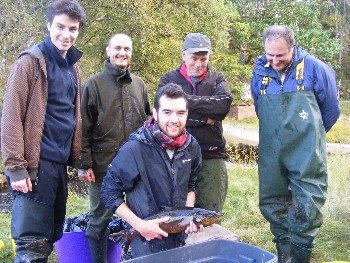Search for sea trout and ferox in spawning burns around Loch Maree
Posted: Thursday 21 November, 2013 @ 17:23:48

During October 2013, we looked for brown trout and sea trout in spawning burns around Loch Maree. With special permission from the Scottish Government, fyke net traps were set in the Slattadale burn and Loch na Fideil burn. A trap was also set in the Taagan burn but was ineffective. In other burns, trout were sampled using electro-fishing equipment.
Our aim was to learn more about the trout populations which spawn in respective burns; and to catch samples of trout from which Glasgow University post-graduate student Martin Hughes (right, holding trout) could obtain eggs to learn more about ferox trout in Scotland as part of his research project.
In previous years we have learned about the composition of adult trout in other spawning burns within the Loch Ewe catchment. Last year (2012) we sampled the adult trout population in a spawning burn flowing into Loch Sguod and found that sea trout were outnumbered 5 to 1 by mature brown trout which had not been to sea (see WRFT Review, July 2013).
This year our efforts to catch adult trout were frustrated by mild weather, high flows; and then just when things got going during the last week of October, WRFT biologist, Peter Cunningham had other commitments. So our samples of trout were rather smaller than anticipated. The trout that we caught were non-migratory brown trout (which had not been to sea). Like the trout in Loch Sguod, these results suggest that the trout populations which spawn in the burns around Loch Maree are also now dominated by non-migratory trout. Sea trout are known to still spawn with brown trout in the burns around Loch Coulin in the headwaters of the River Ewe system.
There is more work to do to find out more about the occurrence of sea trout in different burns and indeed if any sea trout spawn around Loch Maree. However, one conclusion is becoming inescapable: over recent years the trout which remain in freshwater have lived longer than those which have gone to sea.
What can be done to restore numbers of sea trout? A stocking programme has been considered periodically in recent years: e.g. http://www.wrft.org.uk/news/newsitem.cfm?id=113 and maybe could be reviewed again to maximise the number of sea trout smolts which go to sea to provide the best chances of some of them surviving to maturity.
However, low rates of survival of sea trout in the marine environment remains the primary issue. Given recent reports of on-farm sea louse populations in the Wester Ross area (see SSPO fish health reports), prospects of a sustained recovery for the Loch Maree sea trout fishery look as distant as they were 10 years ago.
For help with catching trout, thank you to Martin Hughes, Roddy Legge, Kevin McNeil, Ben Rushbrooke, Kyle McFarlane, Cory Jones, Oliver Hooker, Dr Jennifer Dodds and the SNH Field Station at Kinlochewe.
*For more information about the ‘IBIS’ ferox project, please see article on the RAFTS website, and follow the ferox project at https://www.facebook.com/feroxproject .